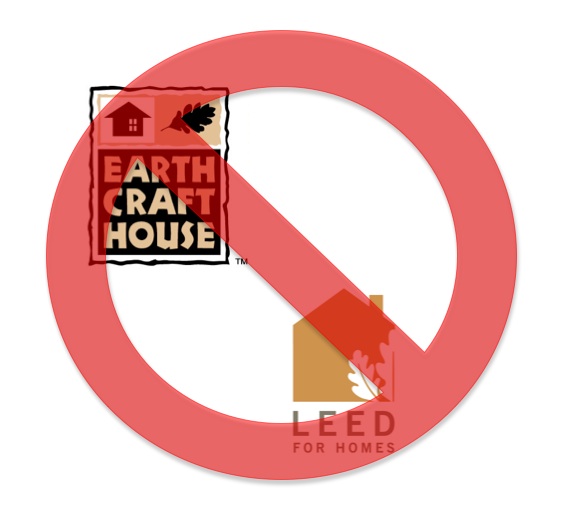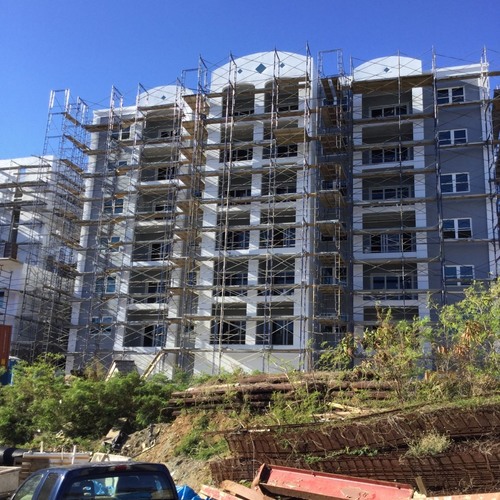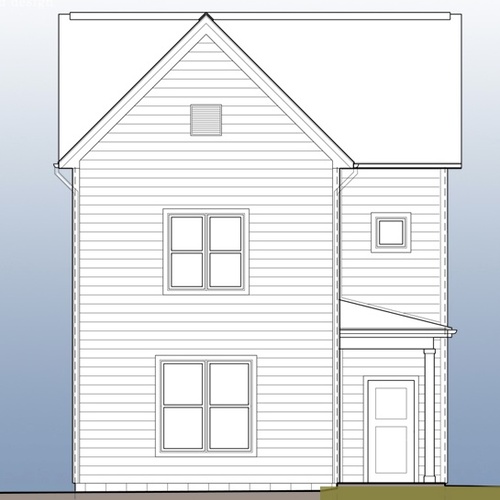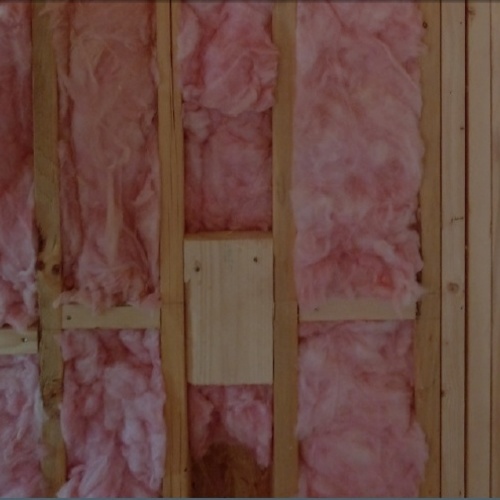
If you had the “pleasure” of reading my first post for this blog, you read about and saw pictures of Felton Homes, the 100-unit affordable rehab project currently underway in Macon, Georgia. After several meetings with the project team, rough inspections of the first sets of buildings, and numerous phone calls and emails, I received a phone call recently informing me that the owner, the Macon Housing Authority, had decided to drop both EarthCraft House and LEED certification due to cost concerns.
While these buildings were planned for ENERGY STAR certification from the very beginning, the green certifications were added late in the process. The changes required to achieve certification resulted in some significant cost increases to meet the various program requirements. Contracts were signed, changes completed, and inspections underway when we realized that there was additional work required, primarily to meet the specific prescriptive requirements of EarthCraft certification. While LEED for Homes had several prescriptive requirements, they ended up being simpler and less costly than those for EarthCraft, but in the end, the required upgrades led to dropping both certifications.
Enlightened Self Interest
While I am disappointed to lose the work, I feel that the bigger loss is the experience of working on and having a project of this scale in my portfolio. The unique character of this project – 100 affordable green gut rehab units – is rare enough that having been an integral member of the team on this development would have been an excellent marketing and public relations opportunity. And there is little I like more than some good marketing and PR.
When the opportunity for the contractor to take the green certifications off the table, I suspect that they were not particularly disappointed. In fact, there is a chance they were happy that the certifications were eliminated from the project. They certainly created additional work for them, and while they were compensated for it, it was unlikely that their increased fees were worth the effort. I expect that if they didn’t push for their client to drop the certifications, they probably didn’t lobby to keep them.
I think by letting the certifications go, the entire team – the contractor, the housing authority, and the architect – are missing an opportunity to be involved in a certified project, something that would likely give them an advantage in the future.
The Bigger Questions
Is this an isolated situation or does it imply a bigger issue in with green building certifications? As I mentioned in my earlier post, over 50% of LEED for Homes certifications are in the affordable sector. While this is a good trend, what is pushing it?
In Georgia, the state provides low-income housing tax credits for affordable developers and the selection process heavily favors green projects, giving heavy weight to projects that guarantee certification. This assures that practically every project awarded these tax credits is green certified. What will happen if or when these tax credits disappear? Will the developers revert back to standard construction practices?
While various incentives and tax credits for energy efficiency and green building are helping to improve the quality of our housing, we need to be looking farther into the future. If sustainable construction is not, in fact, a sustainable business without government support, it may be doomed to fail. We need to be looking to the future and how we can make green building the baseline so that there is nothing else out there. At that point we will be in a position to consider our efforts successful.
Weekly Newsletter
Get building science and energy efficiency advice, plus special offers, in your inbox.















7 Comments
CITY RELAXES STRICT GREEN
CITY RELAXES STRICT GREEN BUILDING POLICY....CERTIFICATION COSTLY....Nanaimo News Bulletin (March 31, 2011)
Increased costs and administration burdens prompted Nanaimo city council to adjust its commitment to LEED standards in new buildings, opting instead for high standards in new buildings without official LEED certification.
In 2006, the city adopted a Green Building Policy that required all new structures achieve at least a Silver level or better for all buildings larger than 500 sq meters.
Since then, two buildings - Oliver Woods Community Center (3,391 sq. meters) and Fire Hall No. 4 (819 sq. meters) were built with significant costs to obtain a LEED certification.
In the case of Oliver Woods, LEED-related architecture, electrical, structural and mechanical engineers and administration resulted in additional costs of $145,275 and considerable staff time, a city staff report indicates. Similar design costs for Fire Station No. 4 were $55,000.
On both projects city staff estimate that LEED documentation and design work added about 20% to each building's design and project management costs, though Oliver Woods is 66% more energy-efficient than similar sized city-owned buildings in Nanaimo.
....."We're doing this because it makes sense"
As a result, the policy will be adjusted to still meet council's environmental priorities for buildings smaller than 900 sq. meters, but without LEED requirements, while buildings larger than 900 sq. meters will follow LEED Gold standards with priorities given to acquiring points in energy and atmosphere, sustainable sites and water efficiency.
Council will also be able to exempt a new building from LEED certification if it can show equivalent green features.
....."a recent forum with home-builders suggested that people in the industry are experiencing similar administration headaches and increased costs to qualify as a LEED building".
In the case of Oliver Woods, several boxes of documentation were shipped to the Canada Green Building Council to achieve LEED standards.
"A lot of people aren't aware there is a dollar cost involved in acquiring a LEED standard," said Nanaimo Mayor John Ruttan. "In some cases it's many thousands of dollars".
Prescriptive Requirements
Carl,
Just curious - what were the prescriptive requirements (for both LEED and EarthCraft) that were so costly?
Construction costs
LEED should also provide a construction methodology that aids actually making these projects within realistic budgets. I.e. you can build x amount of space for x amount of dollars (the budget) and acheive silver status. Currently, the bureaucracy involved to acheive a LEED cert. is harem scarem, leading to inefficiency and undue costs. It isn't an easy formula, but basically its: materials cost plus labor costs equals the price of LEED status. Even if there was estimate it would help.. I don't understand why there is a fee to attain sustainable "best practices" construction in the first place.
Affordability of GREEN
The fact is, in most cases, you get what you pay for. With these programs, you'll pay even more, so if you are committed to building green and want to verify it, open your wallet. I have been involved in Green Building for quite awhile, and there have always been people who swear that building green will save you money, but that is just not true. The fact that a green building is a better building, or at least should be, means that it will cost more. Until our system truly rewards folks for doing the right thing, and until we realize that building better costs more, we will continue to hear the numerous and endless complaints about these verification programs. These programs are more for those who need guidance and prescriptions to building efficiently, and not as relevant to those who are well educated and experienced in green building procedure and techniques. Whose to say that the buildings in this article will be, or perform any differently than they would have going through these programs?
Responses to Your Comments
John- Some of the specific items that increased the costs included single throw valves on washer connections, drain pans under water heaters, crawlspace sealing and conditioning, among others that I can't recall. The real issue was that after they decided to go for certification, other cost overruns came up and they made a financial decision to cut some costs;
Matthew - I don't disagree in theory with your point that certification doesn't necessarily mean that a building will perform better than one that isn't certified, and you are right that the programs are most valuable for those who need help. But, it is also important to have someone overseeing and inspecting projects, even for knowledgeable professionals to make sure that they don't make critical errors. My biggest frustration with the issue of green building costing more is that it only does because as a society, and and industry, we are willing to settle for substandard work as our baseline. Most standard projects don't meet the energy code, the building code, or manufacturer's recommended installation instructions. If we simply did that, we would be well on our way to green building. As things currently stand, since our baseline is crap, then green building has to cost more. Once we start expecting simple competence and compliance with regulations, the differential between green and standard building will be marginal. In the meantime, we will need to continue to look for methods to improve the quality of our work.
Thanks Carl
Well Said....
Too many cooks in the kitchen?
I wonder about the value of green building certification when there are 12 different organizations each offering 4 levels of certification (okay, slight exaggeration) - how is a consumer supposed to keep it all straight, especially as the various certifications mature and change over time? Seems odd to me, but we've created a whole career path for consultants who keep tabs on what all of the certifications mean and spell it out for the rest of the world.
Hopefully the increasing inclusion of performance ratings in various certifications will help to bring the real world into green certifications and make them easier for consumers to understand and compare.
Log in or create an account to post a comment.
Sign up Log in